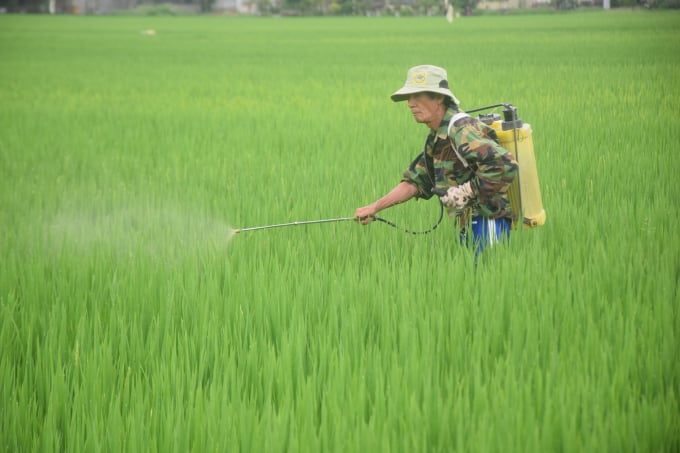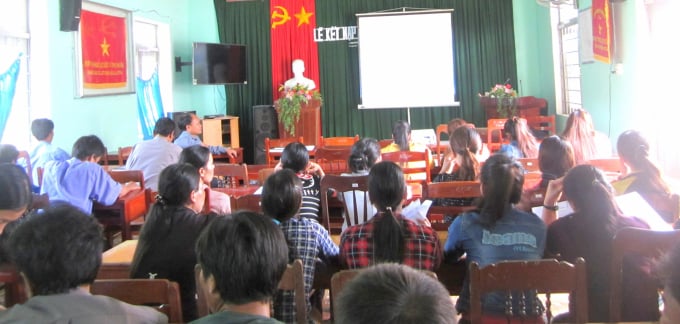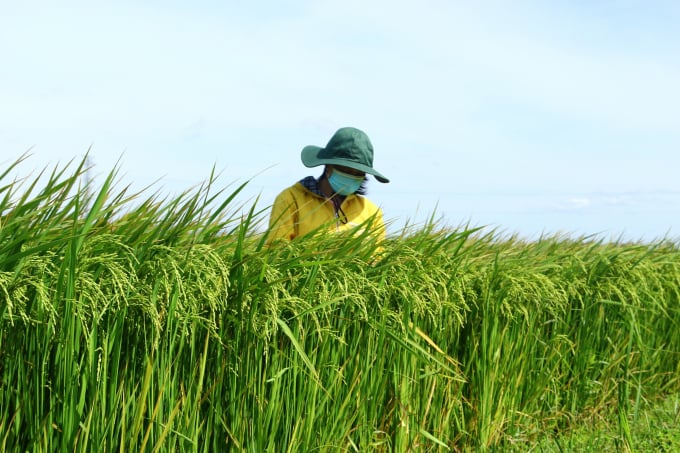May 29, 2025 | 20:00 GMT +7
May 29, 2025 | 20:00 GMT +7
Hotline: 0913.378.918
May 29, 2025 | 20:00 GMT +7
Hotline: 0913.378.918
Several years ago, farmers in Binh Dinh recognized the value of input-cost-saving farming, beginning with the "5 decreases 3 increases" technique, which includes cost-effective irrigation. However, it was not until the System of Rice Intensification (SRI) was launched that farmers in Binh Dinh began to use it widely. Farmers have aggressively implemented those new agricultural practices in response to the rising cost of fertilizer.
According to Ms. Nguyen Thi To Tran, Deputy Director of Binh Dinh's Department of Agriculture and Rural Development, the Binh Dinh agriculture industry will implement cost-saving and balancing fertilizer to reduce input ocst, integrating multi-value into agricultural products, and directing toward a sustainable, responsible, high-added-value, and climate-change adaptive agriculture in the coming years.
According to Ms. Tran, when farmers sow sparingly, that is, when they plant fewer seeds, the appropriate use of fertilizer enables farmers to manage pests in accordance with the spirit of IPM while also lowering fertilizer and plant protection agent costs. Apart from rice, Binh Dinh is implementing integrated pest control processes on peanut plants, which helps farmers save on input costs.

Applying advanced farming processes, Binh Dinh farmers have both reduced input costs and increased production efficiency. Photo: Kim So.
"We will increase communication with farmers to encourage them to lessen their reliance on inorganic fertilizer. Farmers have long shifted away from pure organic produce toward chemical production, which has been firmly embedded in their practices. Additionally, farmers engaged in field farming are no longer the youth, but rather all elderly people, and the land is fragmented, increasing farmers' reliance on inorganic fertilizers. Now, producers are confronted with a difficult problem: resuming production using organic methods. As a result, it is vital to enhance communication, advocacy, and the transmission of innovative agricultural solutions in order for people's farming mindsets to shift "Ms. Tran shared.
Mr. Kieu Van Cang, Director of the Binh Dinh Crop Production and Plant Protection Sub-department, stated that the advanced cultivation method intends to seek efficient measures, and economic advantages, and reduce insect damage, hence increasing agricultural product production and quality. Adopting IPM, ICM, and SRI not only assists in eradicating pest sources but is also vital for regulating ecological balances. As such, advanced agricultural processes must be used systemically, comprehensively, and pro-actively, which means that a range of ways must be combined into a comprehensive and rational system.

Sparse sowing can both reduce rice seed and manage disease according to IPM, so it can limit the use of pesticides. Photo: Kim So.
Mr. Tran Tang Long, Director of Phuoc Hung Agricultural Cooperative (Tuy Phuoc district, Binh Dinh), confirmed: "Advanced farming methods enable farmers to save 40% of rice seed and 25% to 30% of irrigation water; reduce their reliance on chemical fertilizers, pesticides, and care work; and increase their profit by 25% to 35% when compared to traditional production."
According to Mr. Kieu Van Cang, the Binh Dinh Department of Agriculture and Rural Development directed and assigned the Sub-Department of Crop Production and Plant Protection to assume primary responsibility for, and coordinate with, researching, proposing, and developing a plan to deploy the tree production model using effective fertilizers appropriate for local conditions. Simultaneously, implementing fertilizer production models that enable the reuse of by-products from agriculture, animal husbandry, aquaculture, and domestic waste; organizing training and assisting farmers in using and replicating modern agricultural methods to cut input costs.
In recent years, tens of thousands of farmers in Binh Dinh have attended IPM and ICM training courses. ICM and IPM procedures combine complementary measures to produce effects and synergies that increase a plant's good qualities while minimizing the negative effects of pests and diseases. However, while creating IPM, ICM, and SRI processes for crops, the features of the environment, weather, climate, pest condition, farmer's degree of knowledge, and economic ability to adopt appropriate measures must be considered.

Tens of thousands of farmers in Binh Dinh have been trained in advanced farming processes. Photo: Kim So.
Currently, the Binh Dinh Crop Production and Plant Protection Sub-Department are collaborating with the province's and localities' Center for Agricultural Extension to continue transferring and replicating advanced rice farming processes such as IPM, ICM, and SRI into production, thereby increasing productivity and lowering input costs, especially fertilizer and pesticide costs. Maintain and expand large sample fields, particularly those affiliated with rice seed production firms. This year, Binh Dinh continues to conduct 270 large sample fields, of which 266 are rice fields and four are peanut fields, covering a total area of 13,189ha; while maintaining eight large field projects, the Provincial People's Committee approved the project of linking rice seed production, covering an area of 982.3ha "Mr. Cang stated.
Binh Dinh is changing its production pattern from three to two rice crops each year in order to cut production costs while maintaining harvest yield. According to the Binh Dinh Crop Production and Plant Protection Sub-Department, prior crop practices necessitated the use of shorter-day rice varieties with lower yields. Long-day rice varieties may be utilized to produce two harvests of rice each year, leading to high yields and high-quality rice.
"Calculating back and forth, we discover that generating three rice harvests per year is not significantly more expensive than producing two rice crops per year. Meanwhile, agricultural input prices such as seeds, fertilizers, pesticides, plow charges, and labor continues to rise, implying that there is no profit. Producing two rice crops every year allows farmers to have more spare time; once field labor is completed, farmers may perform other occupations to supplement their income," farmer Dinh Van Chung of An Nhon commune disclosed.

Applying advanced farming processes to increase rice yield. Photo: Kim So.
"Previously, Tuy Phuoc district concentrated on converting 100 percent of its area from producing three rice crops per year to two rice crops per year, employing certified rice varieties that are nearly 100 percent original types. Each year, Tuy Phuoc introduces new high-yielding and high-quality rice varieties; the use of innovative technologies such as SRI, ICM, and program 3 results in a threefold increase in productivity. As a consequence, rice and other crops' yields have improved and stabilized. Rice yields are currently averaging 70.7 quintals/ha, up 5.7 quintals/ha from 2011. The purpose of using IPM, ICM, and SRI procedures in farmers' produce is to increase awareness, not to misuse. Using chemical fertilizers and ceasing to spray pesticides on a regular basis, the plant protection business suggests farmers spray when pests and diseases reach a critical level. Farmers may minimize input costs and boost efficiency by managing nutrients properly for crops, according to Mr. Phan Van Khiem, head of the Tuy Phuoc district's Agriculture and Rural Development Department.
Translated by Linh Linh
/2025/05/25/4127-3-073637_820.jpg)
(VAN) Thanks to the promotion from an FAO-implemented project, vegetable production in greenhouses in Moc Chau has seen strong development, from 1.5 hectares in 2021 to nearly 50 hectares in 2024.

(VAN) FAO has recently supported USD 140,000 to implement the project 'Risk mitigation human-animal interface risks through disease control initiatives in pig farming.'

(VAN) The People's Committee of Tra Vinh province has approved an adjustment to the investment policy for the Green Hydrogen Plant project, increasing its area to approximately 52.76 hectares.
![Reducing emissions from rice fields: [2] Farmers’ commitment to the soil](https://t.ex-cdn.com/nongnghiepmoitruong.vn/608w/files/news/2025/05/05/dsc08881jpg-nongnghiep-140632.jpg)
(VAN) Clean rice cultivation model in Thuong Tan commune, Bac Tan Uyen district, is assisting local residents in achieving sustainable agriculture by substantially reducing costs, increasing productivity, and protecting the environment.

(VAN) At the conference to disseminate Resolution No. 68, AgriS introduced its digital agricultural ecosystem and reaffirmed its commitment to accompanying the Government in promoting private sector development and sustainable agriculture.

(VAN) 'Blue Ocean - Blue Foods' initiative is designed to restore marine ecosystems and establish sustainable livelihoods for local communities by cultivating a minimum of 1,000 hectares of cottonii seaweed in the first three years.
/2025/05/21/4642-3-112707_603.jpg)
(VAN) The V-SCOPE project has made direct contributions to three out of six pillars of the Comprehensive Strategic Partnership between Vietnam and Australia.